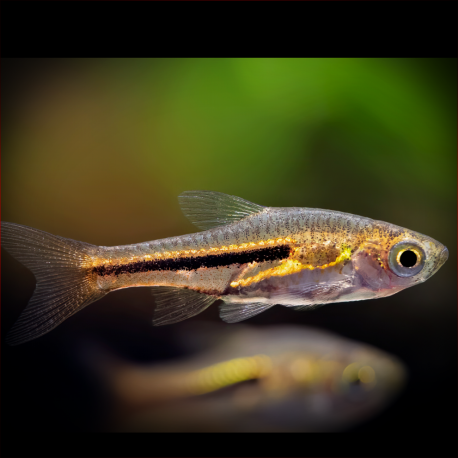More info
Datasheet
| Minimum Tank Size | 60 litres / 15.85 US gallons |
| Maximum Size | 3.0cm / 1.18inches |
| Temperature | 22°C / 71.60°F - 26°C / 78.80°F |
| Hardness | 1.01dgH / 18ppm - 8.01dgH / 143ppm |
| pH | 5.0-7.0 |
General Description
Trigonostigma somphongsi, a rare species within the Rasbora category, was considered potentially extinct until a small number resurfaced in 2006. The dark, wedge-like flank marking of this species distinguishes it from other members of the genus. Found in the Cyprinidae family, this fish reaches a maximum size of 3.0cm.
Aquarium Setup
For optimal care, a tank of at least 60 litres is recommended. The species thrives in a natural setting with soft, sandy substrate, wood roots, and branches creating shaded spots. Decoration with dried leaf litter aids in replicating a blackwater environment, conducive for microbe colonies and fry survival. Dim lighting and plant species like Microsorum, Taxiphyllum, Cryptocoryne, and Anubias are suitable, along with floating vegetation patches.
Behaviour
Trigonostigma somphongsi is a schooling species by nature, making it an excellent community fish when available in larger numbers. It displays schooling behavior and should be kept in groups if possible. However, due to its rarity, emphasis is currently on captive reproduction.
Feeding and Diet
In the wild, this fish is a micropredator, consuming small insects, worms, crustaceans, and zooplankton. In captivity, it accepts a diet of live and frozen foods such as bloodworms, Daphnia, Artemia, along with high-quality dried flakes and granules.
Reproduction & Dimorphism
Captive breeding of Trigonostigma somphongsi is encouraged, with eggs being deposited on broad leaves. Males develop a coppery-orange coloration, while females remain yellowish and are larger and deeper-bodied. The breeding process, while not overly complex, requires specific water conditions and a dimly lit, well-planted tank.
Habitat and Distribution
Endemic to western Thailand, the specific locations where T. somphongsi can be found remain mysterious, with reports from the Mae Klong basin and Ratchaburi province. Its habitat consists of forest streams with thick growths of Cryptocoryne species, soft acidic to neutral water, and dim lighting due to dense vegetation. The construction of dams has threatened its habitat, leading to the endangerment of native species in the region.

